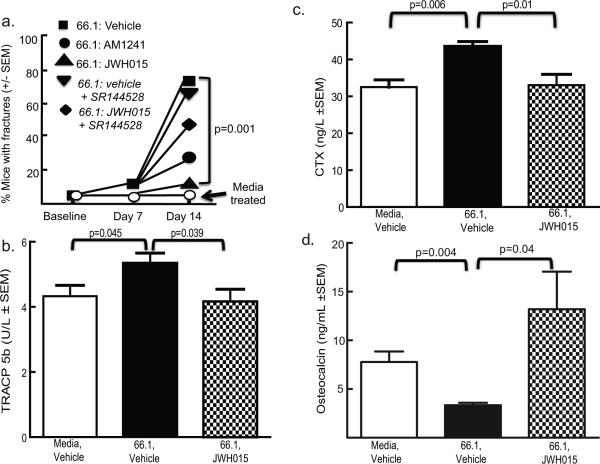Fig. 4.
Sustained CB2 agonist attenuates breast cancer–induced bone remodeling. (A) Based on radiographic images, the number of animals with a clear cortical bone fracture was counted from the different groups of mice at days 0, 7, and 14. Either CB2 agonists, AM1241 (n = 15) or JWH015 (n = 30) significantly reduced the number of animals with cancer-induced cortical fracture of the femoris by day 14 (p = 0.001) compared to vehicle (n = 30); this was blocked by the preadministration of the CB2 antagonist/inverse agonist, SR144528 (p = 0.001; n = 10). Antagonist alone (n = 10) had no significant effect. (B, C) TRACP 5b was measured in animals on day 14 as a marker of osteoclast activity. TRACP 5b levels were significantly higher in animals that received intrafemoral breast cancer cells (66.1) (p = 0.045) compared to intrafemoral media-treated animals. This increase in cancer-induced TRACP 5b levels was significantly reduced in JWH015-treated (6 mg/kg, i.p., q.d., from day 7 to 14) animals (p = 0.039; n = 8). In C, CTX was measured in animals on day 14 as a marker of bone resorption. The amount of CTX was significantly higher in animals that received intrafemoral breast cancer cells (66.1) (p = 0.006; n = 5) compared to intrafemoral media-treated animals. This increase in cancer-induced CTX levels was significantly reduced in JWH015-treated (6 mg/kg, i.p., q.d., from day 7 to 14) animals (p = 0.01; n = 5). (D) Osteocalcin was measured in animals on day 14 as a marker of bone resorption. The amount of OC was significantly decreased in animals that received intrafemoral breast cancer cells (66.1) (p = 0.004; n = 5) compared to intrafemoral media-treated animals. This decrease in cancer-induced OC levels was significantly attenuated in JWH015-treated (6 mg/kg, i.p., q.d., from day 7 to 14) animals (p = 0.04; n = 5).

